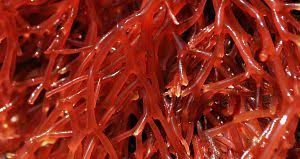Carrageenan, also known as Irish Moss, is used as a texture enhancer to create delightful consumer experiences in a variety of foods and beverages. It is used as a thickener to enhance creaminess in soups and sauces. Carrageenan provides stabilization and decadence in chocolate milks and nutritional shakes. It helps to give that wonderful melted creaminess as you eat ice cream. Carrageenan also suspends nutrients and prevents spoilage in baby formula. In short, it makes foods better!
Unfortunately, carrageenan has been a controversial ingredient in food items since 2008. Most US consumers have seen the warnings from uncredentialed bloggers such as Food Babe and lobbying groups such as Cornucopia Institute suggesting that carrageenan can cause intestinal issues and even cancer. Carrageenan is nothing more than a carbohydrate found in a class of red seaweeds that are considered safe for human consumption. Yes, seaweed. The same bloggers that warn against the consumption of carrageenan, praise diets that include seaweed for its health benefits. Consumers are inundated with claims that having a seaweed rich diet can help thyroid function, provide much needed minerals and even help with weight loss. So, what is a consumer to do with all this conflicting information? How can seaweed be healthy for you but one of its carbohydrates can give you cancer? The answer is this; seaweed is probably not bad for you and carrageenan certainly won’t give you cancer.
To date there are over 11,000 studies on the toxicity, or lack thereof, of carrageenan. According to the FDA, carrageenan can be used safely as a food additive when extracted from the red seaweeds of the class Rhodophyceae. In fact, carrageenan is the only hydrocolloid listed under food additives that is proven safe enough to use in infant formula.[1] Additionally, over the past couple of years countries such as Canada, Sweden and India have produced research that show promising results of a carrageenan based anti-viral drug that can treat human papilloma virus, the leading cause of cervical cancer in women. [2]
As a consumer your next question should be, “If carrageenan is so safe then why are we being told that it is not?” In 2001 a researcher named Joanne Tobacman did a review of studies where it related to carrageenan toxicity and claimed to have discovered a correlation between degraded carrageenan and ulceration of the intestines.[3] This led her down the path to begin claiming that carrageenan can cause inflammation, ulceration, Alzheimer’s and other ailments. As carrageenan is widely used in a variety of foods, both the FDA and independent researchers jumped to dig deeper into these studies to understand the exact mechanisms that carrageenan could be causing these issues. What researchers found is that Tobacman’s methods were not reproducible. She would not reveal the materials used to create her studies or her exact methodology. This is a most egregious crime in the scientific community and without materials and methodology, the study should have never been published. Many scientists now believe that Tobacman studied a completely different material called poligeenan and made an incorrect and erroneous correlation to carrageenan. In the scientific community our saying is: Correlation Does Not Equal Causation. A link must be proven. In 2008 the FDA went so far as to send an open letter to Ms. Tobacman refuting her unscientific claims and reaffirming carrageenan’s safety.[4]
So, then, what is poligeenan? Poligeenan is a low viscosity, low molecular weight, sulfated polygalactan polymer used exclusively in clinical diagnostic applications. Poligeenan is produced by the harsh acid degradation of carrageenan. Carrageenan in solution is processed at low pH (~1.0) and high temperature (90 °C (190 °F)) for up to six hours until the weight-average molecular weight has been reduced to the range 10,000 – 20,000 Daltons. The resulting poligeenan solution is neutralized and spray dried to a fine powder. Carrageenan has a molecular weight of over 100,000 Daltons. Some have claimed that it would be possible for the human body to produce poligeenan from carrageenan during digestion. This is not scientifically possible. The human body does not produce the types of acids and the extreme temperatures needed to create poligeenan.[5]
In 2016 the “watchdog” group Cornicopia Institute falsely claimed that the food industry was part of a large scale cover up to block consumers from information regarding carrageenan safety. From here this mis-information made it into the hands of uneducated and inflammatory food bloggers, such as Food Babe, and the rest is history.
Unlike many countries around the world, the United States does not have laws against companies and private entities making false claims around health, nutrition and safety. This leads to massive amounts of consumer mis-information which causes fear and confusion. With parents struggling to find accurate information on what is best for their families, this type of food fear mongering is unnecessary and cruel. A good rule of thumb when sorting through this information is that if someone is trying very hard to scare you or they are trying to sell you their alternative, it is most likely fake.
[1] FDA Code of Federal Regulations Title 21. Chapter 1 Subpart B. Part 172 Subpart G. Sec. 172.620
[2] “In Vitro Inhibition of Human Papillomavirus Following Use of a Carrageenan-Containing Vaginal Gel.” Gynecological Oncology. Novetsky A, et al. November 2016. And other studies
[3]“ Review of harmful gastrointestinal effects of carrageenan in animal experiments.” Environmental Health Perspective. Tobacman J., Oct. 2001
[4] FDA CFSAN to Joanne K Tobacman MD Petition Denial. Docket # FDA-2008-P-0347-0003. 2008
[5] “What carrageenan is not.” https://marinalg.org/carrageenan-vs-poligeenan





